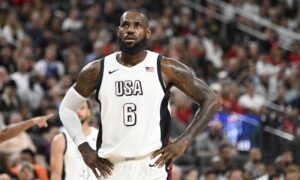No, your eyes are not misleading you, the era of long-distance marksmanship is better for basketball than when there were high-flying dunkers devoid of skill all over the court. The three-point shot is the new dunk.
To all of those people who grew up watching Bill Russell get 30 points and 40 rebounds in Game Seven, or who watched Michael Thompson take vertical leaping to a new height, or Michael Jordan sticking out his tongue as he soared in from the free-throw line in the 1987 Slam-Dunk Contest, or even the kids who grew up throwing lobs to Dr. J on NBA Street, it is out with the old and in with the new.
This year, the Los Angeles Clippers made a higher percentage of threes (41.1%) than any other team in NBA history; from 2017-2020, the Rockets shot a record number of three-pointers for a season; the seven highest marks for most triples made in a season are held by current players (Stephen Curry and James Harden); Damian Lillard has made 13 of 23 shots (56.5%) from 35-39 feet over the past two seasons since he started taking them regularly; the league is more skilled than it ever has been, yet somehow, people have a problem with the direction it is heading in.
For starters, the narrative that defense has disappeared from basketball is fallacious: in fact, it is alive and well, and is just overshadowed by elite offensive talent and the focus on “threes and frees.” Every year, the playoffs show that defense wins championships, whether it be last year’s top-rated Laker defense that held the Miami Heat to eight fewer points per game than they averaged in the regular season, the Cleveland Cavaliers suffocating an explosive 73-9 Warriors team to 89 points in the closeout game, or the 2014 San Antonio Spurs limiting the LeBron James-Dwyane Wade-Chris Bosh-led Heat to 91.6 points per game.
NBA’s Adjustments to the 3-Point Shot
Coaches have wised up and realized that making 33% of threes is worth the same as making 50% of two-point shots, meaning that sinking the league-average 36.7% on shots from beyond the arc translates to more points per game than the league’s standard of 53% on shots inside the perimeter.
Basketball is not the only sport to evolve over the years, either: Major League Baseball teams hit an average of .265 during the 1979 season, 30 years before the most recent full season. In 2019, teams only mustered a mark of .252; that does not mean that players cannot hit at the same level, or that baseball has produced a worse crop of talent in recent years, because the same time comparison shows that modern players hit a combined 1.39 home runs per game compared to .82 in the ‘79 season. Losing a couple of base runners to nearly double the home run total does not mean that baseball is doomed.
In football, analysis of the same years shows that teams sacrificed 40 fewer rushing touchdowns from 1979 to 2019 to gain 259 extra passing touchdowns. This too does not mean that the National Football League has gone down the drain, it just means that offenses have found better ways to attack the defense.
There is nothing more satisfying than watching a monstrous posterizing dunk where a top-tier player rises to slam it over an elite rim defender, or better yet, another star. Jayson Tatum nearly broke the internet with a rim-rocking tomahawk over LeBron James in the Game Seven of the 2018 Eastern Conference Finals, but it did not prevent the Boston Celtics from being eliminated by the Cleveland Cavaliers at the end of the game.
A personal favorite dunk of mine is Dwyane Wade’s thunderous slam over another member of the Cavs, Anderson Varejao. Wade overcame a seven-inch height differential to slam home one of the highlights of his career but could not overcome Cleveland, who won the game by seven.
How the Three-Point Shot has Evolved
Dunks no longer steal momentum in close games; hitting back-to-back threes that make the game up a potential three-possession contest does. The past 10 NBA Finals winners have all shot better from deep than their opponent did, and not by coincidence either.
So, for all of those people who are shouting that today’s players could not survive in the ‘90s, I beg to differ. Unless those players are mimicking Kevin McHale and running around clotheslining everyone— sorry Kurt Rambis— modern players would shoot those players out of the building.
Picture this matchup of 80s and 90s players against some of the best in today’s NBA: Magic Johnson, Michael Jordan, Larry Bird, Karl Malone, and Hakeem Olajuwon versus Stephen Curry, Kobe Bryant, Kevin Durant, LeBron James, and Joel Embiid.
With the bias of nostalgia and “I grew up thinking they were the best” aside, it is hard to say that the old-timers are as skilled all-around as today’s crop. Not only are there current stars that can match the past’s best attributes, whether that be LeBron and Magic in passing, Kobe and Jordan in the mid-range, or Hakeem and Embiid’s physicality, every player on the team of the 2020s can scorch the net from range. I would pay to see fadeaways and dream shakes to keep up with Steph and KD when they get hot from deep.
While we will never get to see the members of the dream team suit up again, it is time for basketball fans to accept that the ways of the old are being left behind for a reason.
Today’s basketball players are better on average than every previous generation, and they are pushing the game forward. The past is the past, and the future is now.
Get on the train or be left behind.
Grant Mitchell is a sportswriter and multimedia contributor for the Sports 2.0 Network dealing with basketball, football, soccer, and other major sports: you can connect with him on Twitter @milemitchell to stay up to date with the latest sports news and to engage personally with him.














